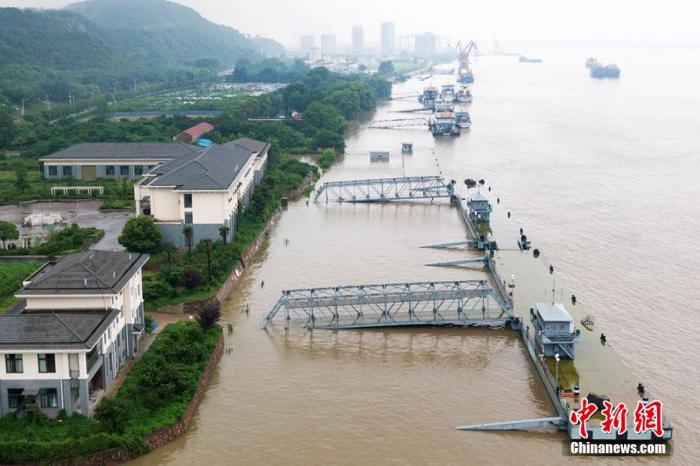China News Agency, Wuhan, July 20 (Reporter Xu Jinbo) Chen Min, Secretary of the Party Group and Deputy Director of the Hydrology Bureau of the Yangtze River Water Conservancy Commission, said on the 20th that since the Yangtze River Basin has entered the main flood season (June to September) this year, rainfall has been consistent with the same period of the year The ratio is much more obvious, and it is characterized by frequent processes, high intensity, long duration and high overlap of rain areas, which leads to the occurrence of over-alarm floods in the river basin involving more rivers and a wider distribution range.
Data map: Aerial photography of the Nanjing section of the Yangtze River, the water level rose. Photo by Tuobo
On the 20th, the Yangtze River Water Resources Commission held a news briefing on watershed drought prevention. Chen Min said that the Yangtze River Basin entered the main flood season from June 1 to July 17, and there were 9 obvious rainfall processes, and the rainfall process was basically uninterrupted. The center of heavy rainfall was located near the main stream of the middle and lower reaches of the Yangtze River and the two lakes (Dongting Lake and Poyang) Lake) in the north of the water system, the accumulated rainfall is more than 500 mm. The rainfall in the river basin was 40% higher than the same period, ranking first since 1961.
Among them, the middle and lower reaches of the Yangtze River were more than 60% higher than the same period, ranking first since 1961; the precipitation in the main stream of the middle and lower reaches of the Yangtze River was more than doubled than the same period, and the Poyang Lake water system was more than 50% more than the same period, which was equivalent to the same period in 1998 .
Especially in early July, the precipitation in the middle and lower reaches of the Yangtze River was 1.6 times more than the average of the same period, which was equivalent to the average annual rainfall in July for the entire calendar year, and 2.3 times more than the same period in 1998; the rainfall in the Poyang Lake system was 3.1 more than the average of the same period. This is 60% more than the July annual average and 7.5 times more than the same period in 1998.
Affected by multiple rounds of strong rainfall in the basin, the two lakes, Qingyi River, Shuiyang River, Chuhe River, Chaohu Lake, Northeast Hubei Rivers and other super-alarms and above floods occurred, and the main stream of the middle and lower reaches of the Yangtze River and the inflow of the two lakes increased rapidly. A total of 226 stations with over-alert floods have occurred since the river basin entered Meimei on June 1, and 143 rivers have been involved. Affected by the above-mentioned incoming water, since July, the main rivers of the Yangtze River and the two lake control stations Lianhuatang, Hankou, Jiujiang, Datong, Qilishan, Hukou and other hydrological stations have successively appeared at the forefront of the highest water level in Hongfeng.
Chen Min said that overall, the floodwaters in the middle and lower reaches of the Yangtze River and the main stream in the middle and lower reaches of the Yangtze River in 2020 were lower than in 1998. However, due to the concentrated rainfall in Poyang Lake in early July, the floods in Poyang Lake encountered high water (or jacking) and caused Poyang The water level of the Lake District and Weilu exceeded 1998, and resulted in the characteristics of rapid flooding, high peak water level, slow backwater and long duration of high water.
At present, the Yangtze River Basin is about to enter a critical period of flood control in the "seventh and eighth up". According to preliminary analysis, in late July, there will still be heavy rainfall in the upper reaches of the Yangtze River, the Han River and the middle reaches of the middle reaches. In August, the northern part of the main stream of the upper Yangtze River has more rainfall, and local floods or flash floods may occur. The flood situation in the Yangtze River Basin will continue to develop further, and the future flood control situation will remain severe. (Finish)

